With over 10,000 orders
With over 10,000 orders
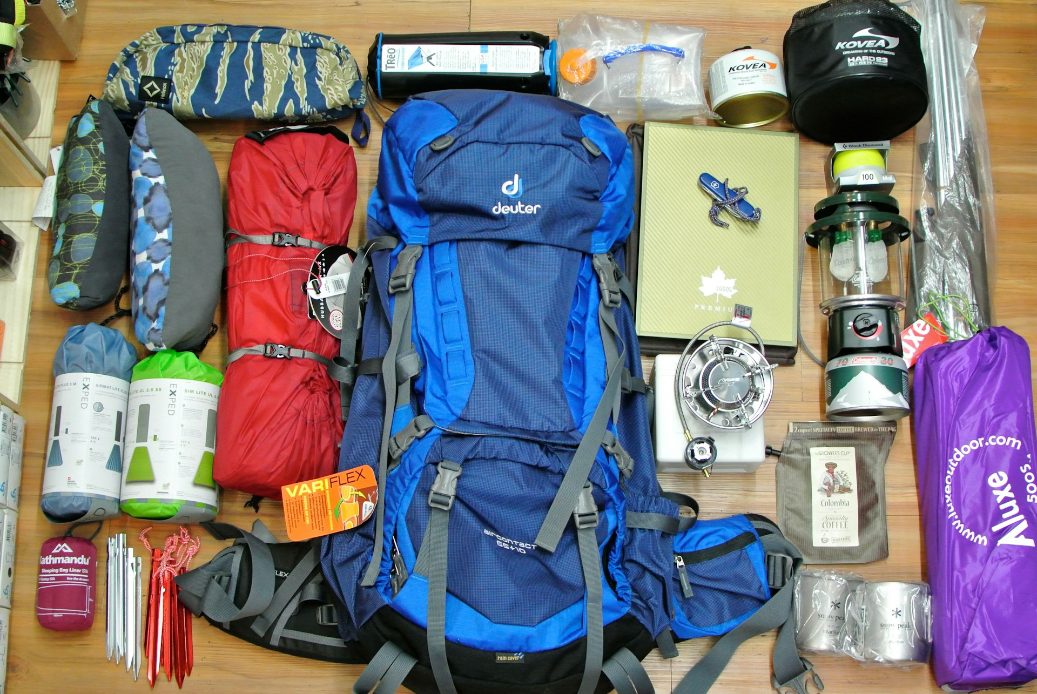
Photo by Karson Chan on Unsplash
Learning how to pack light isn't about some secret technique; it's a mental game. It’s all about ditching the "just-in-case" clutter for a much simpler "just-what's-needed" philosophy. Once you make that shift, you'll find traveling becomes lighter, freer, and a whole lot more fun.
Let's be honest. The biggest thing standing between you and a lighter suitcase isn't the bag itself—it's the fear of leaving something important behind. We’ve all been there, cramming in an extra jacket or a third pair of shoes "just in case." It's a habit that leads directly to heavy, annoying luggage that just complicates everything.
Imagine this instead: breezing through the airport without ever checking a bag. No fees, no waiting at the carousel, and zero anxiety about lost luggage. That kind of freedom starts the moment you get real about what your trip actually requires. Stop packing for every wild possibility and focus on what your itinerary actually demands.
True essentials are the things you know you'll use over and over. "Comfort items," on the other hand, are usually just packed out of habit and almost never see the light of day. A great little mental trick is to ask yourself, "If I end up desperate for this, can I buy or borrow it at my destination?" Most of the time, the answer is a resounding yes.
Going minimalist doesn't mean you have to sacrifice comfort or look like you've been living in the woods. It's about being strategic. For example:
The real secret is to pack for your definite plans, not your vague "what-ifs." This one change will slash your luggage weight and make your entire travel experience way more enjoyable.
To really nail the 'less is more' approach, it helps to look at how experts in other fields do it. For instance, good dive travel tips and tricks are all about packing efficiently for a very specific activity. You can also borrow a ton of great ideas from the outdoor world—we explore this philosophy in our guide on how to become a minimalistic hiker.
The secret to packing light starts long before you pull a single shirt out of your closet. It begins with your choice of luggage. This is probably the single most important decision you'll make, because a heavy bag will sabotage your minimalist travel goals right from the get-go.
Prioritize a carry-on that's lightweight when it's completely empty. You'd be surprised, but some bags can weigh over 7 pounds (3 kg) before you've even packed anything. That's a huge chunk of your weight allowance gone before you start.
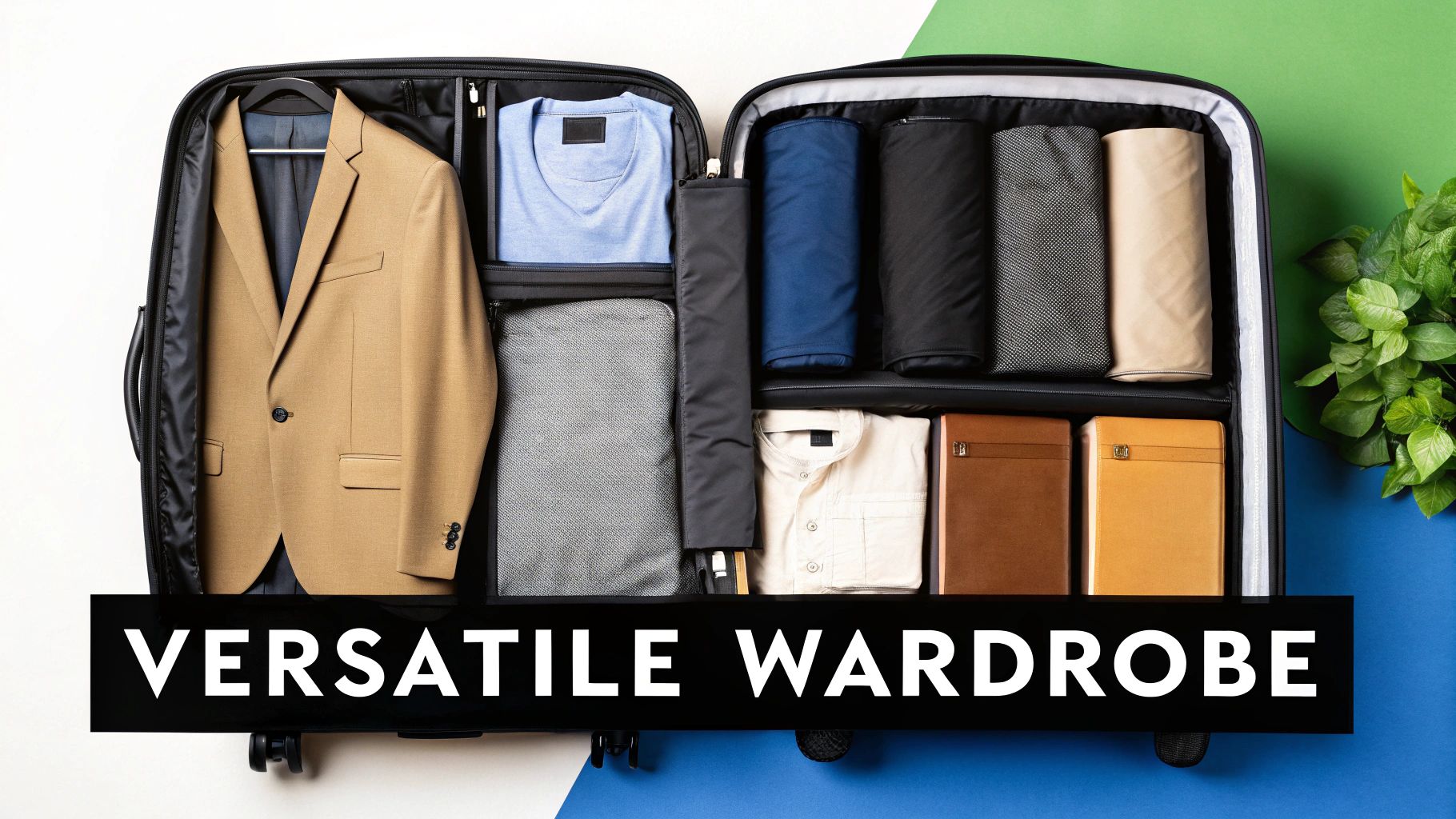
Whether you go for a hard-shell suitcase or a soft-shell backpack really comes down to your travel style. Hard-shell cases are fantastic for protecting fragile items, while soft-shell bags offer more flexibility and those handy external pockets. Whatever you choose, make sure it has durable wheels and a comfortable handle.
The right gear isn't just about the bag itself, though. You'll want to grab a few accessories to maximize your space and keep things organized.
For a lot of us, a travel backpack is the ultimate tool for traveling light. It keeps your hands free and, frankly, forces you to be ruthless about what you bring along.
When you're looking at different backpacks, focus on a comfortable harness system and a solid hip belt. These are crucial for distributing the weight evenly and saving your back. If you want to dive deeper into finding the right one, check out our detailed advice on how to choose a backpack for hiking and backpacking.
Choosing lighter luggage doesn’t just help you out. It actually benefits the entire travel ecosystem. Lighter bags are easier for airline staff to handle and can even reduce the risk of your luggage getting mishandled.
This is more important than ever as global air travel continues to grow. With passenger numbers hitting 3.42 billion back in 2022, airport baggage systems are constantly under immense pressure. While mishandling rates have dropped overall, they saw a scary 75% jump between 2021 and 2022, which really highlights the system's vulnerabilities.
To make your next trip a bit more relaxed, you might want to check out these insights on managing your stress-free airport bag essentials.
If there's one thing that adds the most weight and bulk to a suitcase, it's clothing. Hands down. The fix? A travel capsule wardrobe. This is just a fancy term for a small, hand-picked collection of clothes where everything can be mixed and matched, creating way more outfits than you'd think possible. Learning to pack light is really about getting creative with less.
This isn’t about deprivation; it's pure strategy. Ditch the idea of packing specific "outfits" and start thinking in versatile pieces. Get this right, and you'll never have that moment of staring into a full suitcase and thinking, "I have nothing to wear."
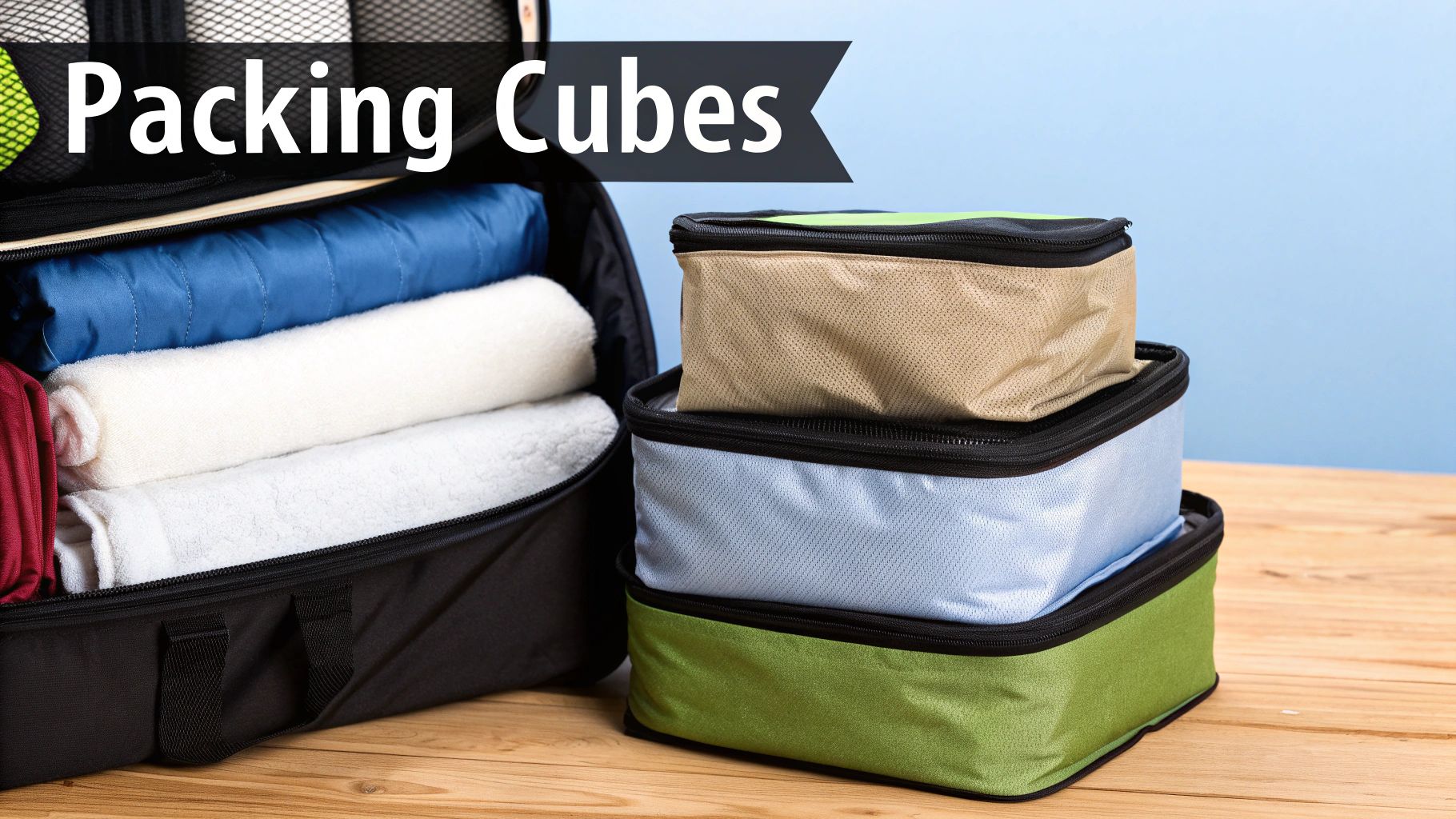
First things first: pick a simple color palette. By sticking to a couple of neutral base colors and maybe one or two accent shades, you guarantee that every top you pack will work with every bottom. This little trick is the bedrock of a killer capsule wardrobe.
A classic formula I always come back to involves:
This framework makes getting ready in the morning a breeze, no matter if you're hitting a museum or grabbing a casual dinner. Everything just goes together.
The core idea is simple: every piece of clothing should be wearable with at least two or three other items in your bag. If an item only works in one specific outfit, it doesn't earn a spot in your luggage.
To give you a clearer picture, here’s a quick example of what a 10-piece capsule might look like for a week-long trip. Notice how each piece can pull double or even triple duty.
| Item Category | Example Piece | Key Feature |
|---|---|---|
| Bottoms (2) | Dark wash jeans | Can be dressed up or down |
| Black travel pants | Wrinkle-resistant, comfortable | |
| Tops (4) | White t-shirt (neutral) | Classic, pairs with everything |
| Striped long-sleeve (neutral) | Adds pattern, layering piece | |
| Blue button-down shirt (main) | Versatile for smart or casual | |
| Burgundy sweater (main) | Warmth, adds a touch of color | |
| Outerwear (1) | Khaki trench coat or jacket | Works in rain or shine |
| Dress (1) | Little black dress (LBD) | Effortlessly chic for evenings |
| Shoes (2) | White sneakers | Comfortable for walking all day |
| Black ankle boots | Good for dinners or dressier days |
With just these 10 items, you can create dozens of unique combinations suitable for almost any activity on your itinerary.
The right fabrics can be a game-changer for light travel. Materials like merino wool are incredible—they’re lightweight, fight off odors naturally, and regulate your temperature. That means you can wear a merino shirt multiple times before it even thinks about needing a wash.
Think in layers instead of packing bulky, one-trick ponies like a huge coat. A smart layering system can handle almost any weather. A merino base layer, a fleece mid-layer, and a waterproof shell, for instance, can take you from a chilly morning hike to a sunny afternoon without needing three different jackets. This strategy is the heart of packing less while being ready for anything.
Picking the right gear is only half the battle. How you pack it can make all the difference in the world. Once you’ve whittled down your essentials, it’s time to get hands-on and make every single inch of your bag count. Think of it less as a chore and more like a satisfying game of Tetris.
First up, the age-old debate: rolling versus folding. For most of your clothes—t-shirts, pants, casual dresses—rolling is the undisputed champion. When you roll items tightly, they take up far less volume than their folded counterparts and can be slotted neatly into the gaps in your bag, minimizing wasted space. For heavier, more structured items like blazers or dress pants, a careful fold might be better to prevent deep creases.
Beyond the simple roll, a few clever tricks can help you reclaim what seems like lost space. Don't let the inside of your shoes become a dead zone! I always stuff mine with socks, underwear, or even a coiled-up belt. This is a classic two-for-one: you save a surprising amount of space, and it helps your shoes hold their shape during transit.
When you start arranging your pack, think about weight distribution. Place your heavier items, like shoes or a toiletry kit, near the bottom of the bag and centered against your back. This creates a stable center of gravity, which makes the bag much more comfortable to carry and keeps it from tipping over. Your lighter, rolled items can then be tucked in around them, filling out the rest of the space.
The image below gives a great visual of just how effective rolling can be.
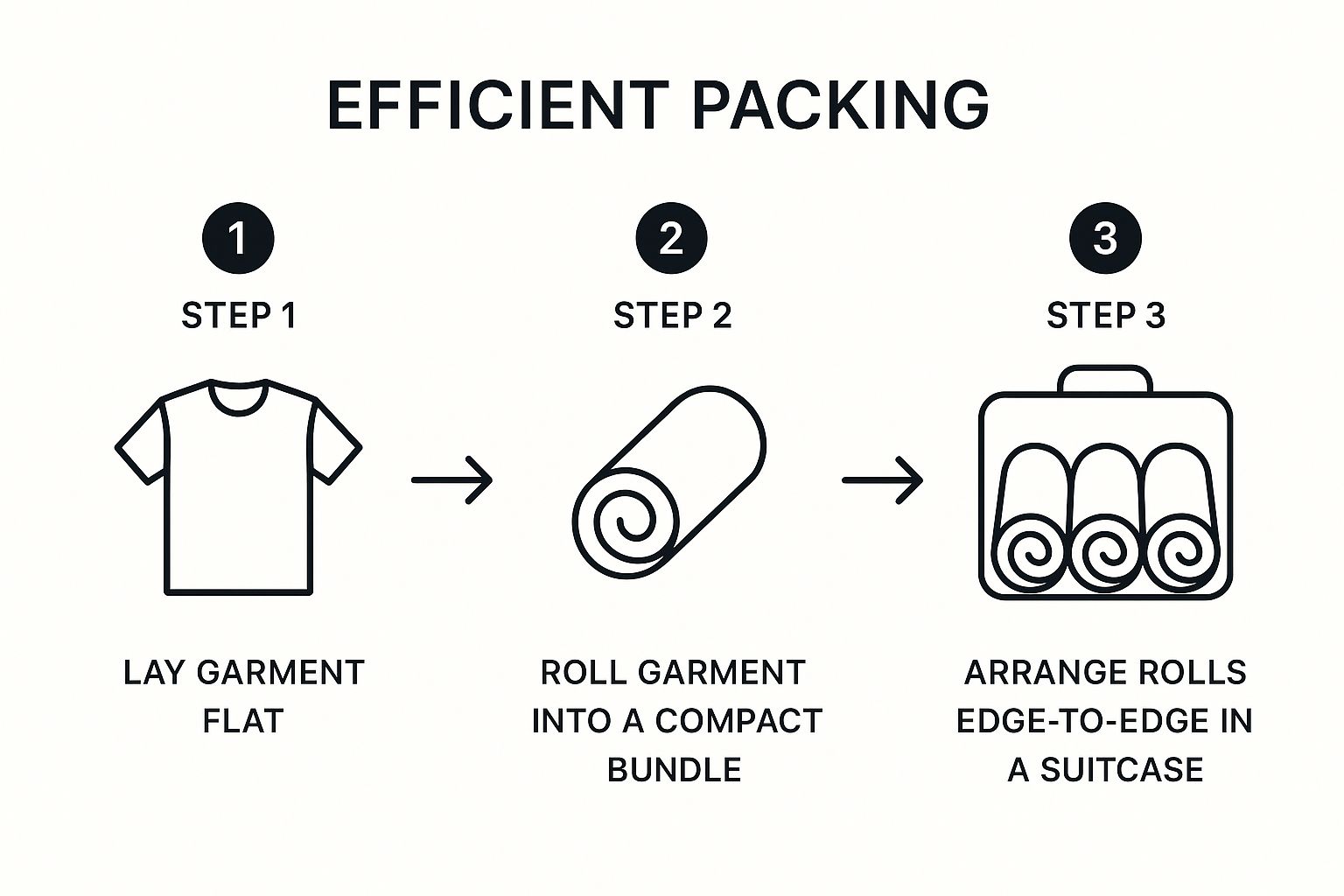
As you can see, turning your garments into compact bundles is the key to both tighter packing and better organization.
Another game-changer for me has been packing cubes. These aren't just for keeping your clothes organized; they're incredible for compression. By packing clothes firmly into a cube and zipping it shut, you can shrink their volume significantly. They’re especially useful for bulky items like sweaters or down jackets. This same principle applies to bigger gear, too. If you're bringing a sleeping bag, learning how to compress a sleeping bag properly is a must.
Toiletries and tech gadgets are the sneakiest culprits when it comes to overweight bags. You think you're packing light, but a handful of small, seemingly harmless items can quickly add up, turning your nimble carry-on into a dead weight. The secret is to get ruthless and strategic about what truly earns a spot in your pack.
When it comes to your toiletry kit, my best advice is to think solid. Ditching liquids for bars is one of the smartest, simplest ways to shed weight and completely sidestep those pesky airport liquid restrictions. I'm talking shampoo bars, conditioner bars, solid perfumes, and even toothpaste tablets. These things are game-changers—they last ages, weigh next to nothing, and you'll never have to worry about a gooey explosion inside your bag again. If you absolutely must bring a liquid, decant it into a tiny travel-sized container. No exceptions.
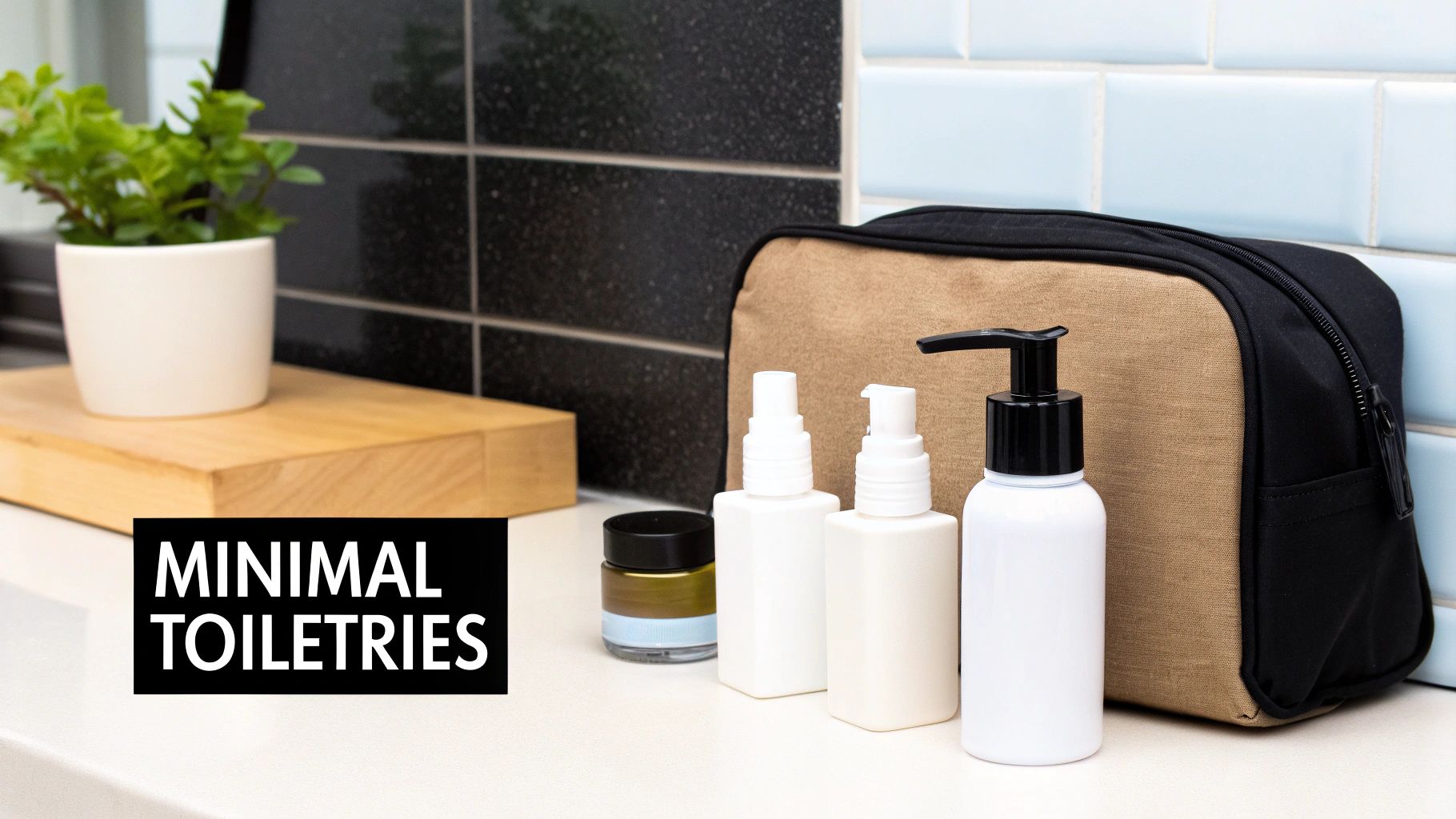
For your electronics, the mantra is consolidation. Why lug around a tangle of bulky power bricks when one multi-port GaN charger can do the job? These modern chargers are small, powerful, and can juice up your phone, headphones, and e-reader all at once.
Embrace the multi-tool you already own: your smartphone. It’s an incredible camera, a GPS, a flashlight, and a library all rolled into one. Leave the redundant, single-use gadgets behind.
This isn't just about making your life easier. Packing lighter is a direct response to how airlines are changing. As the average weight of passengers and their luggage has gone up, airlines have had to tighten their carry-on limits.
This is exactly why every ounce counts. Airlines are constantly re-evaluating weight limits for safety and fuel efficiency. European studies, for example, have shown a clear trend of heavier passengers and bags over the years. With most carry-on allowances hovering between 5 and 8 kilograms, every single item needs to justify its existence. You can learn more about how these weight standards influence airline policies if you want to dive deeper.
By being meticulous with your tech and toiletries, you can easily shave a few pounds off your total pack weight. It's the difference between breezing through the gate and getting hit with an unexpected baggage fee.
Even after you've bought into the minimalist travel mindset, a few practical questions almost always pop up. That's totally normal. Let's walk through some of the most common concerns I hear, helping you clear those final hurdles on your way to mastering how to pack light.
The biggest worry is usually about long trips or traveling through multiple climates with just one small bag. The solution here isn't packing more clothes; it's about having a simple, repeatable strategy. For any trip longer than a week, your plan should just be to do laundry. Pack about seven days' worth of outfits and wash them as you go. This one habit is the secret sauce that makes extended minimalist travel possible.
For trips with shifting weather, layering is your best friend. Instead of hauling a bulky coat, think in three versatile layers. I always bring a merino wool base layer for warmth, a fleece mid-layer for insulation, and a packable waterproof shell for wind and rain. These three pieces can be combined to handle everything from a chilly morning to an unexpected downpour, which means you don't need any single-purpose outerwear.
Another key is just avoiding common pitfalls. The number one mistake I see is packing for "what if" scenarios that have almost no chance of happening. This is how you end up with hiking boots for a city break or a fancy outfit you never wear.
The most common mistake is packing for 'what if' scenarios instead of your actual plans. This results in carrying items you never touch.
A few other errors to watch out for include:
Finally, people often wonder if they need a bunch of expensive, travel-specific gear. While you don't need a whole new wardrobe, investing in a few high-impact items really pays off. A quality, lightweight carry-on and a set of packing cubes are non-negotiable for me. Adding one or two merino wool pieces is also a smart move—their versatility means you can pack less and wear them more often.
At TREKOLOGY, we design the gear that makes lighter, smarter travel possible. From our ultralight pillows to our compact camping chairs, every product is engineered to help you explore more with less. Find the perfect gear for your next adventure at https://trekology.com.
{"one"=>"Select 2 or 3 items to compare", "other"=>"{{ count }} of 3 items selected"}
Leave a comment